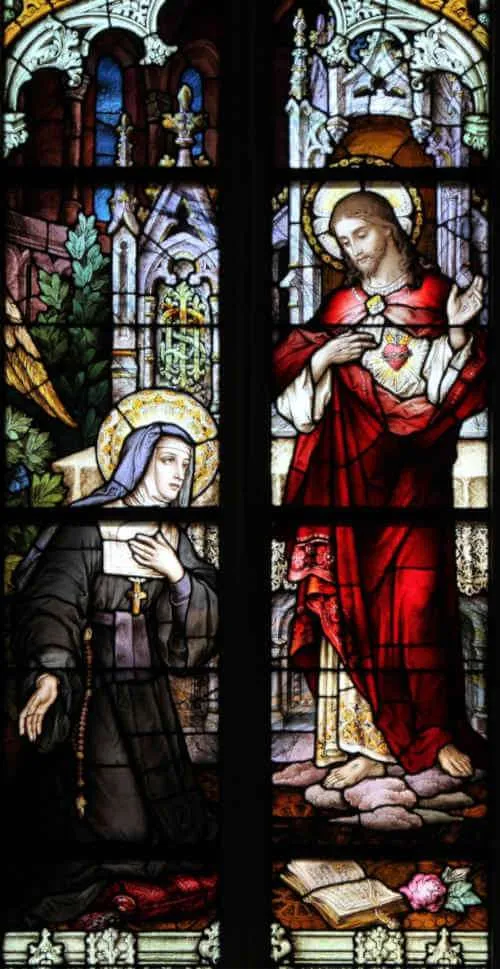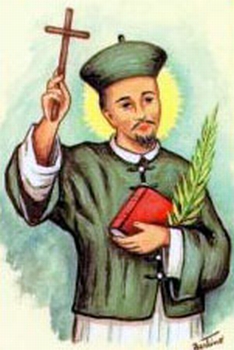1647–1690; Patron Saint of devotees of the Sacred Heart and those who have lost a parent while young; Invoked against polio and rheumatic fever; Canonized by Pope Benedict XV on May 13, 1920
Margaret Alacoque was born either in the small town of Terreau or Hautecour, in the Duchy of Burgundy within the Holy Roman Empire, in modern-day France. She was one of five surviving children, and the only surviving daughter. In her autobiography, she states that from babyhood Jesus claimed her as His own, and once she reached consciousness, Jesus showed her the “ugliness of sin.” As a child, she used to say over and over, “To God I give my purity, and vow perpetual chastity.” One day she prayed it as a vow during Consecration at Mass; however, she admitted that she had no idea what “purity” or “chastity” meant. She only knew she wanted them.
Margaret’s father died when she was very young. Her early education came from other villagers and servants, since her mother spent all her time trying to provide for her children. At the age of nine, she was sent to live with the Poor Clare nuns who educated her. However, after being there only two years, she fell seriously ill, probably with rheumatic fever, and was unable to walk for four years. One day, it was suggested to her that she dedicate herself to the Blessed Virgin Mary, vowing to be one of her daughters if she were cured. As soon as she dedicated herself to Mary, she was cured and the Blessed Mother became the mother of her heart, teaching and correcting her. Shortly afterward, while praying the rosary, the Blessed Mother appeared to her and said, “I am surprised, my daughter, that you are so careless in my service!” This loving reprimand had a profound effect upon Margaret, so much so that when she was confirmed, she added the name Mary to her name, making her Margaret Mary.
Another struggle, turned into a blessing, came in the form of financial hardships after her father’s death. Three of her father’s relatives took charge of the family estate, controlling every aspect of their family’s life. This oppression continued until Margaret Mary was seventeen years old, when her older brother reached the legal age to take back control from his father’s relatives. During those years, however, the oppression and cruelty Margaret Mary and her family endured enabled her to understand the suffering of Jesus more deeply. In fact, Jesus often appeared to her in His suffering and beaten state, teaching her to unite her sufferings and injustices to His own. Jesus spoke to her regularly. Later in life, after revealing these sensible experiences with our Suffering Lord, she was surprised that others did not have the same mystical encounters as she did. These years were also filled with frequent visits to the Blessed Sacrament. When her guardians refused to allow her to go to church to pray, she would spend long hours, and even days, out back in the garden or by the cowshed in solitude on her knees, praying with a sorrowful heart.
Late in Margaret Mary’s teenage years, her mother encouraged her to marry and to abandon the idea of religious life to which she had committed herself since childhood. Because her mother was a widow, she would have little means of caring for herself. Her only hope was that Margaret wed so that she could be cared for in her daughter’s household. Her mother tearfully begged her, over and over, to get married. As a result, Margaret Mary began socializing more and attending dances with her brothers. This tormented her heart; every time she returned home, she was profoundly aware of Jesus’ sorrow. On at least one occasion, after returning home from a dance, Jesus appeared to her as He looked during His scourging at the pillar, revealing His love for her and that her sins caused His suffering. Margaret could take no more of it: little by little, she recommitted herself to her childhood vow to enter religious life.
Once Margaret Mary’s family understood that she had made up her mind to become a nun, they tried to get her to join the Ursulines, which a relative had joined. She desired, however, to embrace the more rigorous life of the Visitation Sisters. Though it seemed that everyone opposed her, she persevered, and, on May 21, 1571, she entered the Visitation Convent at Paray-le-Monial. As soon as she entered the parlor for her initial visit, she interiorly heard Jesus say, “It is here that I would have thee be.” After some doubts by her superiors as to whether she was a good fit for the Visitation Sisters, she received the habit and took her vows on November 6, 1572.
During Margaret Mary’s novitiate, Jesus revealed to her that He had a special mission for her. She was to become a blank canvas on which Jesus’ sufferings would be written and revealed. After Margaret Mary made her vows, Jesus repeatedly appeared to her, revealing to her His desire that His Sacred Heart be honored, and uniting her soul more deeply with His sufferings. On the eve of every first Friday, Jesus inspired her to make a holy hour from 11:00 p.m. until midnight, lying prostrate so as to enter into His human sorrow that He suffered while abandoned by the Apostles in the Garden. On the first Friday, she was instructed to receive Holy Communion. Jesus instructed her that He desired all people to love Him and to come to know the love of His Heart. On the Friday after the octave of the Solemnity of Corpus Christi, Jesus asked that a feast be established in honor of His Sacred Heart. At one point, Jesus said to her, “My divine Heart is so inflamed with love for mankind, and for you in particular, that it can no longer contain within itself the flames of its burning charity and must spread them abroad by your means.” She saw Jesus’ Heart on fire and crowned with thorns. The flames represented Jesus’ burning love for humanity, and the thorns represented the sinful and ungrateful response of men.
Jesus made twelve promises to those who would honor His Sacred Heart: “I will give them all the graces necessary for their state of life. I will establish peace in their families. I will console them in all their troubles. They shall find in My Heart an assured refuge during life and especially at the hour of their death. I will pour abundant blessings on all their undertakings. Sinners shall find in My Heart the source of an infinite ocean of mercy. Tepid souls shall become fervent. Fervent souls shall speedily rise to great perfection. I will bless the homes where an image of My Heart shall be exposed and honored. I will give to priests the power of touching the most hardened hearts. Those who propagate this devotion shall have their names written in My Heart, never to be effaced. The all-powerful love of My Heart will grant to all those who shall receive Communion on the First Friday of nine consecutive months the grace of final repentance; they shall not die under my displeasure, nor without receiving their Sacraments; My heart shall be their assured refuge at that last hour.”
Sister Margaret Mary shared her visions with Mother de Saumaise, who doubted their authenticity. Her superiors expressed concern that Sister Margaret Mary was not living the normal prayer life of a Visitation sister. They expected her to pray certain vocal prayers and engage in various prescribed meditations. But how could she? She was a mystic, being drawn into a profound communion with Jesus. He was already with her, communing with her in the depth of her soul. She certainly could not abandon Jesus Himself so as to engage in more superficial prayers.
Eventually, her superior began to believe Margaret Mary but had her submit her visions and mystical experiences to theologians who judged her to be delusional. Many of the sisters doubted her also. By God’s providence, Jesuit Father and future saint, Claude de la Colombiere, became the sisters’ confessor. Upon listening to Margaret Mary, he believed her and helped to support the authenticity of these visions. Toward the end of Margaret Mary’s life, her community began to accept the revelations and observed the Feast of the Sacred Heart, building a chapel to the Sacred Heart three years before her death. Seventy-five years after her death, after thorough examination, Pope Clement XIII approved devotion to the Sacred Heart of Jesus, paving the way for Margaret Mary’s canonization, which would not take place until 1920, and the inclusion of this feast on the General Roman calendar, which took place in 1929.
Today, there is no doubt that Saint Margaret Mary Alacoque lived a profoundly mystical life and that the revelations she received came directly from Jesus. During her life, however, she suffered greatly through mystical union with her crucified Lord. She faced continual opposition as she sought to fulfill God’s will, being mocked, ridiculed, and considered delusional. But God uses those whom this world writes off for great things. The devotion to the Sacred Heart of Jesus that our Lord gave to the Church through her has become an enduring and transforming devotion in countless lives.
As we honor this great saint, ponder your own depth of devotion to Jesus’ suffering Heart. Reflect upon the twelve promises Jesus made to those who honor His Heart. As you do, renew and deepen your devotion to Him in this way so that you will become a greater recipient of His abundant mercy.
Source: https://mycatholic.life/saints/saints-of-the-liturgical-year/october-17–st-margaret-mary-alacoque/








